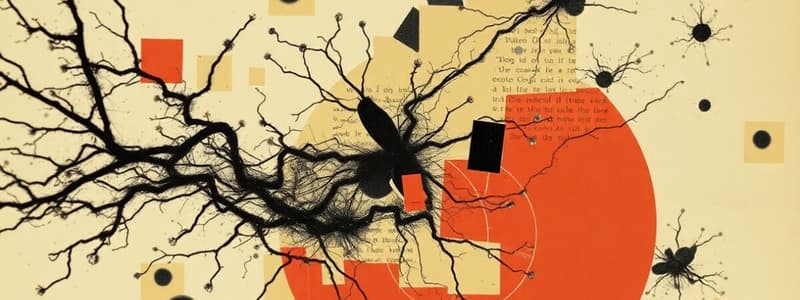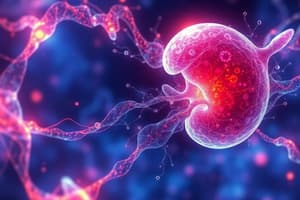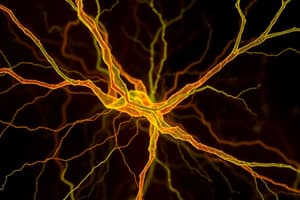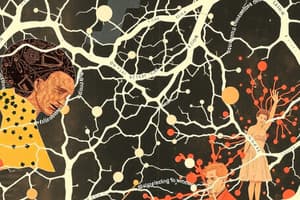Podcast
Questions and Answers
Which Rho-GTPase is primarily associated with the formation of lamellipodia?
Which Rho-GTPase is primarily associated with the formation of lamellipodia?
- WASP
- Cdc42
- Rho
- Rac (correct)
C3 transferase inhibits the activity of Rac.
C3 transferase inhibits the activity of Rac.
False (B)
What complex is responsible for nucleating actin filaments de novo?
What complex is responsible for nucleating actin filaments de novo?
Arp2/3 complex
The protein that enhances the depolymerization of actin is known as __________.
The protein that enhances the depolymerization of actin is known as __________.
Match the following Rho-GTPases with their associated structures:
Match the following Rho-GTPases with their associated structures:
Which of the following is NOT a bundling protein that cross-links actin filaments?
Which of the following is NOT a bundling protein that cross-links actin filaments?
Actin filaments are characterized by having a uniform diameter of approximately 10 nm.
Actin filaments are characterized by having a uniform diameter of approximately 10 nm.
What is the term used to describe the process where subunits add to one end of an actin filament while they come off the other end?
What is the term used to describe the process where subunits add to one end of an actin filament while they come off the other end?
The barbed-end of an actin filament is also known as the ______ end.
The barbed-end of an actin filament is also known as the ______ end.
Match the following terms with their correct descriptions:
Match the following terms with their correct descriptions:
What is the critical concentration required to start adding monomeric actin at the minus end?
What is the critical concentration required to start adding monomeric actin at the minus end?
What is one of the main roles of actin in non-muscle cells?
What is one of the main roles of actin in non-muscle cells?
Small GTPases play no role in the regulation of actin assembly.
Small GTPases play no role in the regulation of actin assembly.
Actin is composed of a single type of protein with no isoforms.
Actin is composed of a single type of protein with no isoforms.
Name one of the three sources of new actin filament formation mentioned.
Name one of the three sources of new actin filament formation mentioned.
What are the two domains present in G-actin?
What are the two domains present in G-actin?
Actin assembly requires energy from the hydrolysis of ______ to ______.
Actin assembly requires energy from the hydrolysis of ______ to ______.
Stable structures formed by actin filaments in cells include __________.
Stable structures formed by actin filaments in cells include __________.
Match the following actin structures with their descriptions:
Match the following actin structures with their descriptions:
Which class of actin is primarily found in skeletal muscle?
Which class of actin is primarily found in skeletal muscle?
B-actin is involved in membrane ruffles and is increased in cells with high movement.
B-actin is involved in membrane ruffles and is increased in cells with high movement.
What is the state of actin after ATP hydrolysis?
What is the state of actin after ATP hydrolysis?
Profilin increases the critical concentration needed for actin assembly.
Profilin increases the critical concentration needed for actin assembly.
What is the net addition of subunits during actin polymerization predominantly occurring?
What is the net addition of subunits during actin polymerization predominantly occurring?
The process of adding and losing actin subunits is known as ______.
The process of adding and losing actin subunits is known as ______.
Match the actin-binding proteins with their functions:
Match the actin-binding proteins with their functions:
Which phase of G-actin polymerization does ATP hydrolysis occur?
Which phase of G-actin polymerization does ATP hydrolysis occur?
Actin polymerization is unfavorable in most cell types.
Actin polymerization is unfavorable in most cell types.
What is one unique property of profilin?
What is one unique property of profilin?
The ______ end is where filament elongation is favored.
The ______ end is where filament elongation is favored.
What is one of the functions of thymosin-b4?
What is one of the functions of thymosin-b4?
What role does capping protein play in actin assembly?
What role does capping protein play in actin assembly?
Thymosin-b4 enhances polymerization by making G-actin assembly-competent.
Thymosin-b4 enhances polymerization by making G-actin assembly-competent.
Which actin-binding protein has a greater affinity for ATP-actin compared to ADP-actin?
Which actin-binding protein has a greater affinity for ATP-actin compared to ADP-actin?
The critical concentration for ATP-actin at the plus end is _______ µM.
The critical concentration for ATP-actin at the plus end is _______ µM.
Match the following actin-binding proteins with their functions:
Match the following actin-binding proteins with their functions:
What is the predominant growth direction for actin filaments?
What is the predominant growth direction for actin filaments?
The free G-actin is primarily in the ADP form.
The free G-actin is primarily in the ADP form.
What mechanism is used by free G-actin to regulate its assembly?
What mechanism is used by free G-actin to regulate its assembly?
Actin-binding proteins can be classified as ______, ______, and ______.
Actin-binding proteins can be classified as ______, ______, and ______.
What is a key characteristic of the critical concentration for actin?
What is a key characteristic of the critical concentration for actin?
Flashcards
Actin Microfilaments
Actin Microfilaments
Protein filaments involved in cell movement, contraction, shape changes, and other cellular processes.
Cell Motility
Cell Motility
The ability of a cell to move from one place to another.
G-actin
G-actin
Globular monomeric form of actin protein, the building block of actin filaments.
Actin Isoforms
Actin Isoforms
Signup and view all the flashcards
Lamellipodia
Lamellipodia
Signup and view all the flashcards
Microvilli
Microvilli
Signup and view all the flashcards
Focal Adhesions
Focal Adhesions
Signup and view all the flashcards
Actin Filament Polarity
Actin Filament Polarity
Signup and view all the flashcards
Arrowhead Decoration
Arrowhead Decoration
Signup and view all the flashcards
Critical Concentration
Critical Concentration
Signup and view all the flashcards
Treadmilling
Treadmilling
Signup and view all the flashcards
De Novo Nucleation
De Novo Nucleation
Signup and view all the flashcards
Uncapping
Uncapping
Signup and view all the flashcards
Actin Assembly Requirements
Actin Assembly Requirements
Signup and view all the flashcards
Actin Binding Proteins
Actin Binding Proteins
Signup and view all the flashcards
Cell Signalling and Actin Assembly
Cell Signalling and Actin Assembly
Signup and view all the flashcards
ATP Hydrolysis in Actin
ATP Hydrolysis in Actin
Signup and view all the flashcards
Actin Filament Ends
Actin Filament Ends
Signup and view all the flashcards
What is the ATP cap?
What is the ATP cap?
Signup and view all the flashcards
Profilin's Role
Profilin's Role
Signup and view all the flashcards
Profilin: Nucleotide Exchange Factor
Profilin: Nucleotide Exchange Factor
Signup and view all the flashcards
Actin Assembly in vivo
Actin Assembly in vivo
Signup and view all the flashcards
Why is G-actin above critical concentration?
Why is G-actin above critical concentration?
Signup and view all the flashcards
What are filopodia?
What are filopodia?
Signup and view all the flashcards
What is the role of Rho GTPases in actin regulation?
What is the role of Rho GTPases in actin regulation?
Signup and view all the flashcards
What is the function of the Arp2/3 complex?
What is the function of the Arp2/3 complex?
Signup and view all the flashcards
How does WASP activate the Arp2/3 complex?
How does WASP activate the Arp2/3 complex?
Signup and view all the flashcards
What is the significance of Listeria's hijacking of the actin machinery?
What is the significance of Listeria's hijacking of the actin machinery?
Signup and view all the flashcards
What caps the barbed end of actin filaments?
What caps the barbed end of actin filaments?
Signup and view all the flashcards
What does Thymosin-b4 do to G-actin?
What does Thymosin-b4 do to G-actin?
Signup and view all the flashcards
Why does the minus end tend to disassemble?
Why does the minus end tend to disassemble?
Signup and view all the flashcards
What is the effect of a free barbed end?
What is the effect of a free barbed end?
Signup and view all the flashcards
What are the two main actin filament growth points?
What are the two main actin filament growth points?
Signup and view all the flashcards
How does the ATP state of G-actin affect its behavior?
How does the ATP state of G-actin affect its behavior?
Signup and view all the flashcards
What is the role of capping proteins in actin dynamics?
What is the role of capping proteins in actin dynamics?
Signup and view all the flashcards
What are some major categories of actin-binding proteins?
What are some major categories of actin-binding proteins?
Signup and view all the flashcards
How do formins affect actin assembly?
How do formins affect actin assembly?
Signup and view all the flashcards
What is the function of Filamin?
What is the function of Filamin?
Signup and view all the flashcards
Study Notes
Actin Microfilaments
- Actin is very abundant, comprising 20% of skeletal muscle mass and 5% of total proteins in non-muscle tissues.
- Actin plays crucial roles in cell motility, contractility, shape changes, cytokinesis, cell polarity, phagocytosis, and macropinocytosis.
- Actin assembly is crucial for membrane ruffles, lamellipodia formation, and cell movement in non-muscle cells.
- Actin assembly is initiated and regulated by various factors, including the type and activity of actin binding proteins, and cell signaling.
- Actin proteins are highly conserved, with 375 amino acids and a molecular weight of 43 kDa.
- Actin exists in at least six isoforms in mammals, each encoded by separate genes.
- Actin is categorized into three classes:
- Class 1: Non-muscle β, γ and smooth muscle γ-actin.
- Class 2: Skeletal, cardiac and vascular α-actin
- Class 3: Actin-RPV, centractin, lower eukaryote actins.
- Actin isoforms exhibit specific localization within cells.
- γ-actin is primarily found at the cell periphery.
- α-actin is concentrated within stress fibers.
- β-actin is associated with membrane ruffles, a process involved in cell movement.
- Actin filaments are polarized, with distinct plus (+) and minus (-) ends exhibiting different assembly rates and kinetics.
- The assembly of actin filaments requires ATP hydrolysis which regulates the assembly and disassembly process.
- Cell Signaling alters actin assembly through small GTPases, including Rac, Rho, and Cdc42.
- Actin assembly proceeds through three stages:
- Nucleation: Initial formation of actin filaments.
- Polymerization: Elongation of actin filaments.
- Steady state: Equilibrium between actin filament assembly and disassembly.
Actin Structures in Cells
- Transient/labile structures: Lamellipodia, Filopodia, Ruffles
- Stable structures: Microvilli
- Actin-associated junctions: Focal complexes, focal adhesions
- Actin is crucial for cell movement and shape changes.
- The presence of actin associated proteins contributes to a variety of cellular functions.
Stable Actin Filament Structures
- Microvilli are fingerlike projections on cell surfaces, particularly in epithelia like the intestines.
- Microvilli increase surface area for absorption by forming bundles of 20-30 actin filaments that have their barbed ends facing the tip of the microvilli.
- Actin filaments in microvilli are crosslinked by the bundling proteins villin, fimbrin, and espin.
Actin Filaments - Control and Regulation
- Actin filaments are polarized, with distinct plus (+) and minus (-) ends.
- Actin assembly requires energy from nucleotide (ATP-ADP) hydrolysis in cells.
- Actin binding proteins regulate the ratio of monomer to filament.
- Cell signaling through small GTPases (Rac, Rho, and Cdc42) alters actin assembly to modulate cellular processes.
Actin assembly into filaments
- Pure actin nucleates as trimers and grows by monomer addition.
- The resulting filaments are typically found in bundles or networks.
- Filaments have a diameter of 6-8 nm and are composed of polar subunits arranged in a right-handed double-helical structure.
Actin Filament Polarity
- Actin filaments exhibit polarity with different kinetics at plus (+) and minus (-) ends.
- Myosin decoration reveals a characteristic arrowhead pattern: barbed end (+ end) and pointed end (- end)
- Critical concentration for assembly is lower at the barbed end (plus end).
Actin Assembly
- Subunits add and detach from both ends of filaments, but critical concentrations differ, allowing for treadmilling.
- Plus end has a lower critical concentration (0.1 μM), enabling subunit addition with a higher rate compared to the minus end (0.8 μM)
Formation of New Actin Filaments
- New filaments can be formed by three mechanisms: de novo nucleation, uncapping, and severing existing filaments.
Actin binds ATP
- Actin tightly binds ATP and Mg++.
- ATP is then hydrolyzed to ADP after polymerization.
- ATP binding determines polymerization and depolymerization rates.
Structures of monomeric G-actin and F-actin filaments
- G-actin is a globular monomeric protein with two domains.
- F-actin is a filamentous polymer with a double helix arrangement of G-actin subunits.
Formation of New Actin Filaments (cont.)
- Actin assembly occurs spontaneously from ATP-bound G-actin monomers.
- ATP is hydrolyzed to ADP after polymerization, lagging behind.
- ATP cap marks the end of filament.
- ADP-actin marks the de-polymerization state.
Actin Polymerisation
- Actin polymerization involves the addition of monomers to the plus end (+), with a higher rate of assembly compared to the minus end (-).
- The process has three stages: nucleation, elongation and steady state.
Regulation of filament formation by actin-binding proteins
- Several key actin-binding proteins, including profilin, cofilin, and thymosin-β4, regulate actin filament dynamics and thereby affecting cellular processes.
- These proteins manipulate the assembly and disassembly of actin filaments.
- The interaction sites between actin monomers are affected by the various proteins. (This is often detailed in the diagram)
Actin Binding Proteins
- Various actin-binding proteins affect actin assembly and stability
- Several functions are categorized in the various types of binding proteins.
Actin Ends - Summary
- Actin growth predominantly occurs at the plus (+) end.
- Critical concentration for ATP-actin differs between plus and minus ends (0.1 μM vs 0.6 μM respectively.)
- This difference results in treadmilling, maintaining a constant flux of monomers.
Free Ends and Free Subunits
- Free G-actin monomers are largely present in ATP-bound state making them likely to become incorporated into filaments.
- G-actin complexes with actin-binding proteins regulate actin assembly.
- Capping proteins control the addition of G-actin to the ends of existing filaments, which regulates F-actin growth.
Actin-Binding Proteins: Polymer modifying proteins
- Multiple proteins regulate actin filament formation, stability and function.
Actin Binding Proteins: Over 50 known
- Many proteins impact actin assembly, stability, and function.
- These proteins categorized as severing, capping, crosslinking, and bundling, have diverse roles in cell structure and dynamics.
Actin-binding proteins-regulators of assembly & branching
- Profilin binds G-actin (ATP state).
- Arp2/3 proteins initiate branched actin networks.
- Thymosin-β4 sequesters G-actin (preventing assembly).
- Tropomodulin caps the minus end of actin filaments to inhibit disassembly.
Actin binding proteins-regulators of assembly & cross-linkers
- Several proteins control actin assembly, crosslinking, and attachment.
- Cofilin accelerates disassembly and actin filament severing.
- Gelsolin severs filaments.
- α-actinin bundles filaments, and filamin crosslinks them..
- Tropomyosin stabilizes and modulates filament stability.
Actin associations at a cell edge (and adjacent pages)
- Actin forms complex networks and interactions at the leading edge of migrating cells.
- These contribute to cell protrusion, locomotion, and sensing of the environment.
- Various proteins and complexes affect actin dynamics at cellular edges, leading to changes in protrusion rate and shape.
Actin dynamics and cell protrusions
- Cell surface receptors, Rho family GTPases and signaling proteins such as WASP and SCAR, Arp2/3 complex, capping proteins, and profilin/cofilin are all controllers of actin dynamics that impact cell protrusions like filopodia and lamellipodia
Rho-GTPases
- Rho, Rac and Cdc42 are key signaling molecules in controlling actin dynamics.
- Each is responsible for driving the formation of different actin-based structures such as stress fibers or lamellipodia.
Regulation of the state of actin in cells
- Actin constantly remodels, redistributes, and reassembles. Its dynamics are regulated by signaling pathways and external stimuli.
- Changes to actin configuration occur locally and are controlled by small GTPases such as Rac, Rho, and Cdc42.
How the role of Rac/Rho/cdc42 in actin regulation was discovered
- Experiments with serum-starved cells demonstrated the role of these proteins.
- C3 transferase, a chemical, inactivates Rho and is used as a tool to determine Rho's impact on actin function.
Spatial and temporal regulation in response to external stimuli
- Signaling pathways regulate initiation, branching and growth of actin filaments in response to external stimuli like hormones, growth factors, and cell-to-cell signaling.
Nucleation-promoting factors, rapid filament assembly at the plasma membrane
- Nucleation-promoting factors (NPFs) like WASP and Scar drive actin filament assembly near the plasma membrane.
- The Arp2/3 complex is a crucial component in this process by inducing branching and creating complex actin networks.
- Actin monomers, profilin, formins, and nucleating factors function cooperatively at the leading edge of the cell.
Fish "keratocytes" - model systems for studying movement
- Fish keratocytes are used to study cell movement processes.
The Arp2/3 Complex
- Arp2/3 is a complex of seven proteins that nucleates actin filaments "de novo."
- It promotes actin filament branching and is highly concentrated at the leading edge of the cell in response to external stimuli.
- Arp2/3 proteins are controlled by activation signals through factors like WASP or WAVE.
Arp2 and Arp3 share structural homology to actin
- Arp2 and Arp3 share common structural features with actin, contributing to their function in actin filament nucleation.
Regulating actin structures
- ECM, growth factors, hormones regulate actin structures (filopodia, lamellipodia).
- Cdc42 controls the protrusion through regulated actin interactions with proteins.
Steps in cell movement
- Cell movement is a multi-step process involving extension, adhesion, translocation, and de-adhesion.
- Actin-based structures and interactions are essential components in each step, allowing the cell to extend structures, attach and move across a substrate and then detach and recycle.
Contribution of Cdc42, Rac, and Rho to cell movement
- Cdc42 activation promotes actin assembly and treadmilling at the leading edge.
- Rac activation is needed for the formation and regulation of the lamellipodium.
- Rho activation leads to myosin II activation, promoting stress fiber contraction and pulling the cell body forward
Rac - Lamellipodium formation
- Rac activation is needed for the formation and regulation of lamellipodia through Arp2/3 complex activation, capping protein and cofilin activity.
- During Rac-driven lamellipodia formation, other proteins facilitate a series of branching actin networks.
Dendritic Nucleation Model
- Arp2/3 complex nucleates new filaments at the side of pre-existing filaments forming Y-junctions, promoting branching and anchoring for further elongation in the lamellipodium.
Dendritic Actin Network
- Arp2/3 complex is present in Y-junctions and promotes the dendritic branching patterns seen in lamellipodia.
Hijacked by parasites
- Parasites such as Listeria, Shigella, and Helicobacter hijack actin machinery for their invasion and spread inside host cells
Steps in cell movement (cont.)
- Specific actin-based structures, like lamellipodia and filopodia, are formed to assist cell movement.
- This helps with recognition of the substrate and extension of growth processes.
Studying That Suits You
Use AI to generate personalized quizzes and flashcards to suit your learning preferences.




